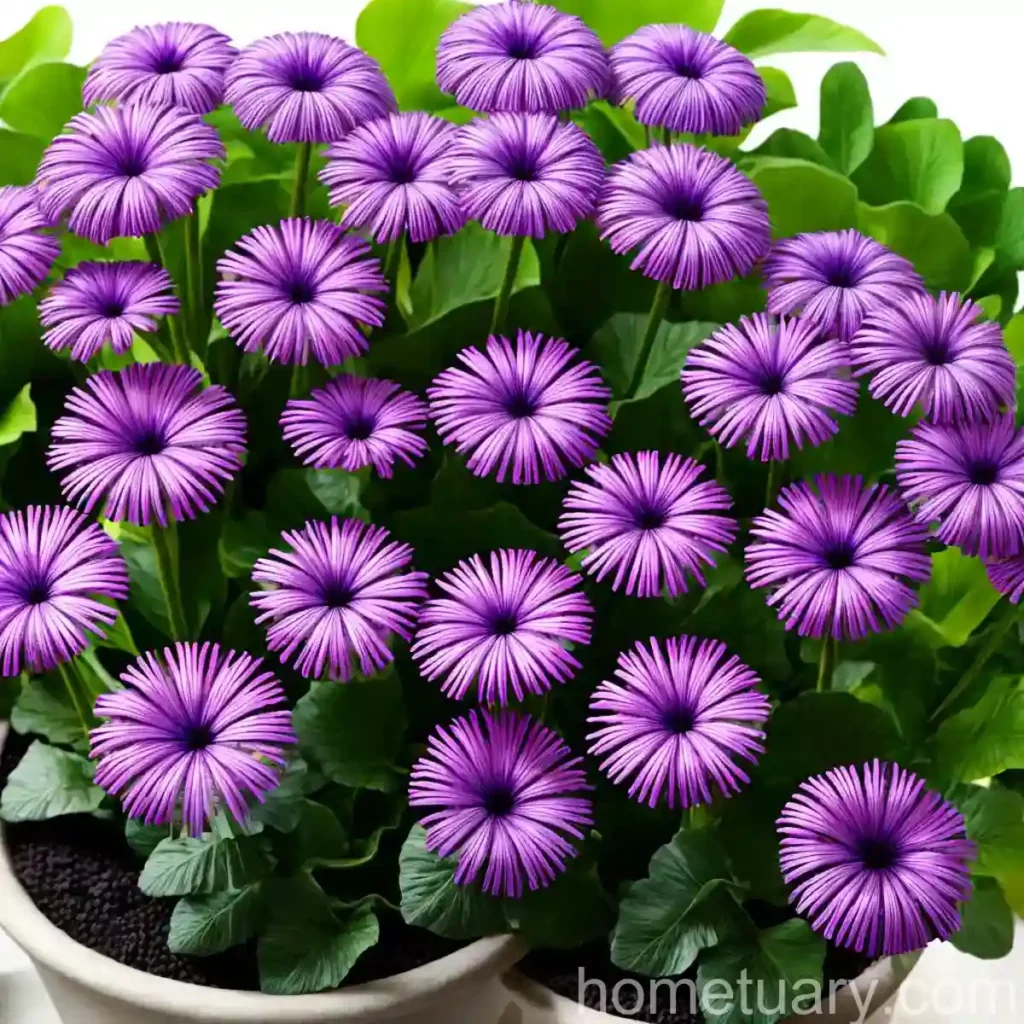Florist’s Cineraria (Pericallis x hybrida): A Complete Guide to Care, Cultivation, and Uses
Florist’s cineraria (Pericallis x hybrida) is a delightful flowering plant that has gained popularity as an indoor ornamental plant. With its vibrant blooms and ease of care, it has become a favorite among gardening enthusiasts and florists alike. In this comprehensive guide, we will delve into the various aspects of caring for florist’s cineraria, its uses, and interesting facts about this charming plant.
What is Florist’s Cineraria (Pericallis x hybrida)?
Florist’s cineraria, scientifically known as Pericallis x hybrida, is a hybrid species that belongs to the Asteraceae family. It is a compact, bushy plant that produces an abundance of daisy-like flowers in a stunning array of colors, including shades of blue, pink, purple, and white. This plant is native to the Canary Islands and is prized for its long-lasting blooms, making it a popular choice for indoor and outdoor display.
Key Takeaways
Before we delve into the specific care and cultivation requirements of florist’s cineraria, let’s take a brief look at the key takeaways that will be covered in this guide:
- Florist’s cineraria thrives in cool, bright environments and requires regular watering to maintain its lush foliage and colorful blooms.
- This plant is commonly used as an ornamental or decorative plant, adding a pop of color to indoor spaces and gardens.
- Proper watering, suitable sunlight exposure, well-draining soil, and regular fertilization are essential for the healthy growth of florist’s cineraria.
- Pruning and propagation techniques are vital for maintaining the plant’s shape and expanding its presence in the garden or home.
Culture
Understanding the cultural requirements of florist’s cineraria is crucial for ensuring its optimal growth and blooming. Let’s explore the specific cultural needs of this beautiful plant to help you create an ideal environment for its cultivation.
Uses
Florist’s cineraria is primarily used for ornamental purposes, as it adds a touch of elegance and vibrancy to indoor and outdoor spaces. It is commonly featured in floral displays, potted arrangements, and garden borders due to its striking flowers and contrasting foliage.
Water
Proper watering is essential for the health and vitality of florist’s cineraria. The plant thrives in consistently moist but well-draining soil. However, it’s important to avoid overwatering, as waterlogged conditions can lead to root rot and other issues. To maintain optimal soil moisture, ensure that the plant is watered when the top inch of the soil begins to dry out.
Sunlight
Florist’s cineraria flourishes in bright, indirect light or partial shade. While it requires a good amount of light to bloom profusely, direct sun exposure should be limited, especially during the hottest parts of the day. A location with morning sun and afternoon shade is often ideal for this plant, as it provides the necessary light without the risk of scorching the delicate foliage.
Fertilizer
Regular fertilization is essential for promoting healthy growth and abundant blooming in florist’s cineraria. During the growing season, which typically spans from late winter to early spring, the plant benefits from a balanced, water-soluble fertilizer applied at half the recommended strength every two to four weeks. It’s important to cease fertilization during the plant’s dormant period to prevent nutrient buildup and potential damage to the roots.
Soil
Florist’s cineraria thrives in well-draining, slightly acidic soil. A high-quality potting mix designed for flowering plants or a combination of peat moss, perlite, and coarse sand can provide the ideal growing medium for this species. Additionally, ensuring proper soil aeration and moisture retention is crucial for the plant’s overall health and vigor.
Pruning
Regular pruning is beneficial for maintaining the compact and bushy appearance of florist’s cineraria. It also helps to remove spent blooms, encourage new growth, and shape the plant to your desired aesthetic. When the flowering period concludes, trim back any leggy or overgrown stems to promote a more balanced and attractive form for the plant.
Propagation
Propagating florist’s cineraria can be achieved through stem cuttings or division. When propagating through stem cuttings, select healthy, non-flowering stems and root them in a moist, well-draining medium. It’s important to provide proper warmth and humidity to encourage successful rooting. Division is another effective method, especially when the plant becomes overcrowded, as it allows for the creation of new, vigorous plants from the parent specimen.
Container Popularity
Florist’s cineraria is widely appreciated for its suitability as a container plant. Whether displayed indoors or outdoors, its compact size, striking flowers, and attractive foliage make it a popular choice for embellishing various container arrangements and garden features.
Common Diseases
While florist’s cineraria is generally robust, it is susceptible to certain diseases that can affect its overall health and appearance. Being aware of these common diseases and their symptoms is essential for implementing timely preventive measures and treatments to safeguard the plant’s well-being.
Disease Diagnosis
The following are some of the common diseases that may affect florist’s cineraria:
-
Powdery Mildew: This fungal disease presents as a powdery, white coating on the foliage of the plant. It can weaken the plant and inhibit its growth if left untreated.
-
Botrytis: Also known as gray mold, this fungal disease typically occurs in cool, humid conditions. It appears as fuzzy gray or brown spots on the leaves and petals, potentially causing the plant’s decline if not addressed promptly.
-
Leaf Spot: Leaf spot diseases manifest as dark, water-soaked spots on the foliage, often leading to leaf yellowing, wilting, and premature leaf drop.
-
Root Rot: Excessive moisture or poor drainage can lead to root rot, characterized by darkened, mushy roots and a general decline in the plant’s health.
Common Pests
In addition to diseases, florist’s cineraria may also attract certain pests that can negatively impact its growth and overall condition. Identifying and addressing these pests promptly is vital for protecting the plant from potential damage.
Botanist’s Tips
To effectively manage pests and diseases, consider the following botanist’s tips:
-
Monitor Plant Health: Regularly inspect your florist’s cineraria for any signs of pests or diseases. Early detection can significantly improve the plant’s prognosis and minimize the need for intensive treatments.
-
Maintain Optimal Growing Conditions: Providing the plant with appropriate cultural conditions, including proper watering, sunlight exposure, and well-draining soil, can bolster its natural defenses against pests and diseases.
-
Prune Prudently: Removing dead or infected plant material through selective pruning can help mitigate the spread of diseases and eliminate potential hiding spots for pests.
Fun Facts
As you embark on your journey of caring for and enjoying the beauty of florist’s cineraria, here are some fun facts about this captivating plant:
-
Symbolism: Florist’s cineraria is often associated with purity and affection, making it a popular choice for conveying heartfelt sentiments in floral arrangements and decorative displays.
-
Medicinal Traditions: In traditional medicine, certain species within the Pericallis genus have been used for their purported medicinal properties, with applications ranging from wound healing to respiratory health support.
-
Flower Colors: Florist’s cineraria exhibits a wide range of flower colors, allowing for diverse and vibrant displays that can cater to various decorative themes and preferences.
Links to External Resources
For further exploration of florist’s cineraria (Pericallis x hybrida) and its cultivation, uses, and characteristics, consider these valuable external resources:
- The Plant List – Pericallis x hybrida
- Royal Horticultural Society: Growing Florist’s Cineraria
- University of Florida IFAS Extension: Cineraria Production Guide
In conclusion, florist’s cineraria (Pericallis x hybrida) is an enchanting plant that offers a wealth of beauty and charm to any indoor or outdoor setting. By understanding and implementing the appropriate care and cultivation practices, you can savor the delightful blooms and lush foliage of this exquisite species, enriching your gardening experience and surrounding environment with its allure and vibrancy. Whether you’re an avid gardener, an aspiring florist, or simply a lover of botanical wonders, the florist’s cineraria is sure to captivate and inspire with its enduring elegance and botanical grace.
With its striking blooms and compact form, the florist’s cineraria (Pericallis x hybrida) is a charming addition to any garden or home. By adhering to the outlined care guidelines and embracing the unique attributes of this stunning plant, you can cultivate an enchanting display that celebrates the beauty and resilience of florist’s cineraria.















